Successful heritage soapmaking relies on complementary herb combinations that deliver both visual appeal and therapeutic benefits. You'll find remarkable results pairing calendula with chamomile for sensitive skin, or combining lavender and yarrow to fight acne. For seasonal creativity, match spring herbs like chamomile with autumn's rosemary, or enhance exfoliation by blending oatmeal with calendula. Don't overlook regional traditions—Mediterranean olive oil soaps with rosemary or Nordic pine-infused blends offer authentic heritage formulations for your artisanal creations.
Natural Herb Combinations For Heritage Soapmaking Success
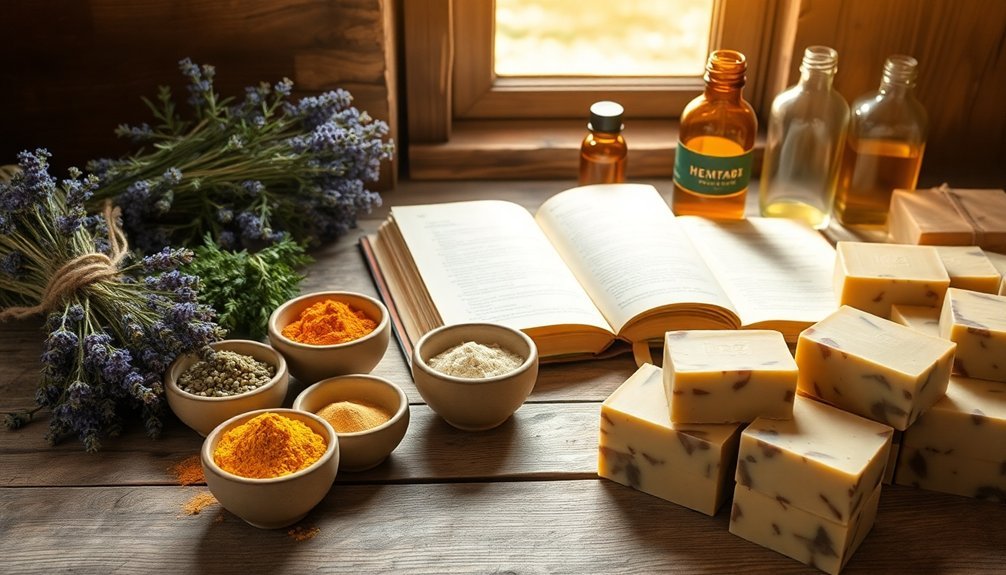
While modern soapmaking often relies on synthetic additives, heritage techniques embrace nature's bounty through carefully selected herb combinations. When you make your own soap, consider pairing calendula with chamomile for a visually striking bar that soothes sensitive skin.
For rejuvenating garden-inspired soap recipes, combine dill and lemon balm—the dill provides vibrant green specks while lemon balm adds calming properties.
Using herbs like powdered peppermint leaves creates light green tones that complement the invigorating aroma when paired with peppermint essential oil.
Don't overlook infusing oils with dried herbs such as yarrow or nettle before soapmaking. This technique extracts anti-inflammatory benefits and unique colors.
When working with lavender in herbs and flowers combinations, remember it browns during curing—consider applying the buds solely as a decorative topping.
Classic Herbal Duos That Enhance Therapeutic Benefits
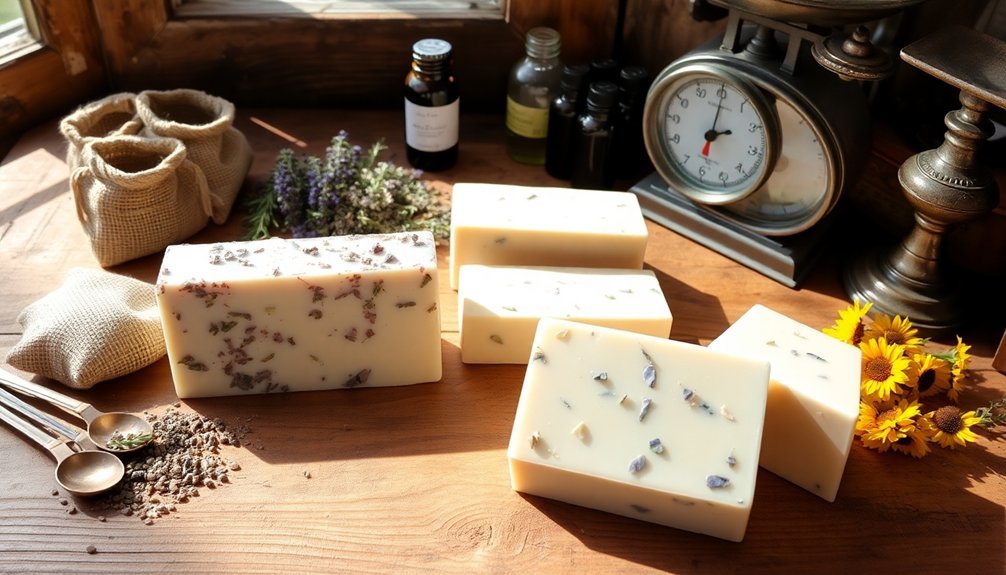
Because herbs often work synergistically, certain combinations can dramatically amplify the therapeutic effects of your handmade soaps.
When you're crafting traditional soaps, these time-tested pairings deliver both aesthetic appeal and skin benefits.
- Chamomile tea and lavender buds – This calming combination merges antibacterial properties with a soothing scent, creating a relaxing experience that's perfect for evening use.
- Calendula and dill – These herbs create a visually stunning soap with powerful anti-inflammatory benefits, making them ideal for sensitive or irritated skin conditions.
- Peppermint essential oil and rosemary – This invigorating duo stimulates circulation while the rosemary provides gentle exfoliation, resulting in a soap that awakens your senses and revitalizes tired skin.
Garden-to-Soap: Seasonal Pairings for Year-Round Creation
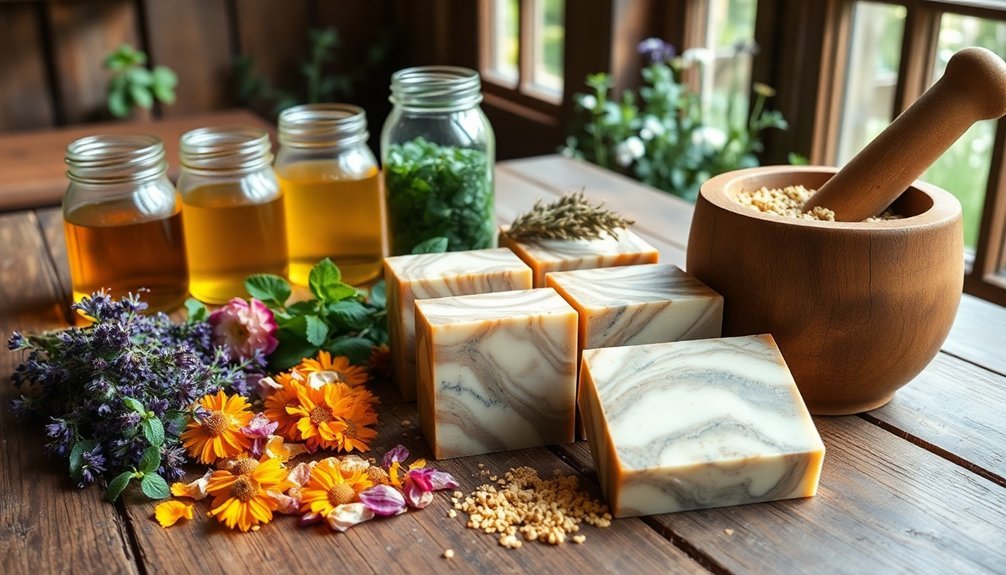
How often have you gazed at your garden and wondered which herbs might transform into extraordinary soap creations? Your seasonal herb harvest offers perfect soapmaking opportunities throughout the year.
In spring and summer, infuse calendula and chamomile in oils to capture their skin-soothing properties and vibrant hues.
As autumn arrives, shift to rosemary and peppermint, which provide invigorating scents and natural exfoliation for your fall soap recipes.
Don't stop when winter comes—dried lavender and lemon balm maintain their calming effects while adding visual interest to cold-weather batches.
This garden-to-soap approach isn't just economical—it connects your creations to nature's rhythms.
Try pairing herbs strategically: chamomile's golden color and antibacterial benefits complement yarrow's anti-inflammatory properties for truly therapeutic natural soaps.
Color-Stable Herb Combinations for Visually Stunning Soaps
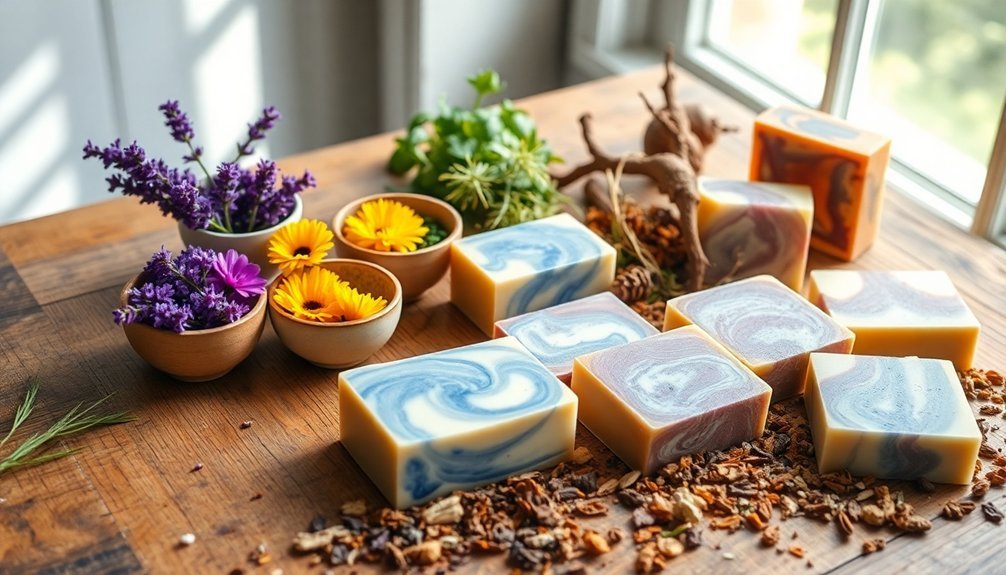
Natural beauty in soap doesn't need to fade away. When adding color to your soap, choosing the right herbs can prevent disappointing browning in your finished bars.
Calendula petals maintain their vibrant yellow or orange hues, while nettle infusions provide adjustable green tones that won't fade.
For stunning color combinations that stay true, try these proven pairings:
- Infuse chamomile in oil for a golden base, then top with dried lavender buds for contrast
- Create a green nettle-infused soap body topped with cornflowers for a striking blue accent
- Layer calendula-infused oils with chamomile to create gradient effects from orange to gold
Beneficial Blends for Specific Skin Conditions
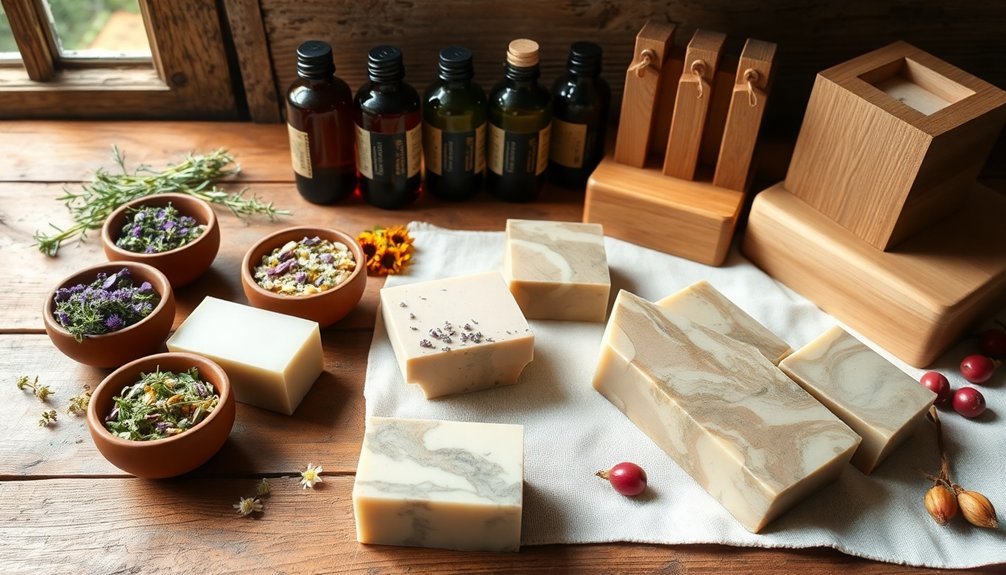
Creating soap that addresses specific skin concerns requires thoughtful herb combinations that work synergistically for maximum benefit.
For sensitive or irritated skin, pair Calendula with Chamomile to harness their combined soothing, antibacterial, and anti-inflammatory properties.
If you're battling acne or skin irritations, try Lavender and Yarrow together. This powerful duo calms the skin while fighting bacteria that can worsen breakouts.
For poison ivy reactions or severe rashes, Goldenseal and Jewelweed create an effective remedy soap that reduces inflammation and soothes affected areas.
Consider peppermint with nettle for improved skin texture and reduced inflammation, or explore dill with lemon balm for a mood-lifting soap that's gentle on sensitive skin.
Each blend offers targeted benefits while maintaining the natural integrity of traditional soapmaking.
Historical Soap Recipes Reimagined With Modern Techniques
The art of soapmaking has evolved remarkably through centuries, yet today's crafters can breathe new life into historical recipes through contemporary methods.
You'll find that traditional herbs like lavender and calendula can be incorporated into handmade soap using modern techniques that enhance their beneficial properties.
When making soap from scratch, consider these historical reimaginings:
- Replace harsh wood ash with precisely measured sodium hydroxide, creating gentler products that still honor ancestral formulations.
- Infuse oils with seasonal herbs like rosemary and thyme before adding essential oils for complex, authentic scent profiles.
- Add dried flowers such as cornflowers strategically during the trace phase to prevent browning while maintaining historical aesthetics.
This herbs change represents the perfect marriage between time-honored wisdom and contemporary soapmaking science—respecting tradition while embracing innovation.
Layering Herbs for Multi-Dimensional Sensory Experience
Skilled artisans know that layering herbs strategically transforms ordinary soap into a sensorial masterpiece that engages multiple senses simultaneously. When you're natural soap making, consider how lavender buds prevent browning while adding both visual appeal and fragrance to your soap recipe.
The herbalist behind exceptional creations understands that complementary combinations heighten therapeutic qualities. Try pairing invigorating peppermint with calming chamomile, or antibacterial yarrow with soothing calendula. These thoughtful combinations deliver both aesthetic beauty and skin benefits.
You'll achieve striking visual effects by incorporating herbs at different stages of the process. Create swirls and patterns by adding calendula for golden hues and lavender for purple undertones.
When combined with essential oils, these layered herbs create a multi-dimensional experience that elevates your soap from simple cleanser to aromatic art.
Complementary Exfoliants and Softening Herbs for Balance
Finding the perfect exfoliant-softener balance in your soap creates a superior cleansing experience that's both effective and gentle.
You'll discover transformative combinations like oatmeal with calendula, specialized clay-herb scrubs that purify without harshness, and strategic botanical buffers that protect sensitive skin.
These pairings allow you to customize your soap's texture while maintaining the therapeutic benefits of each carefully selected herb.
Oatmeal Meets Soothing Calendula
While herbalists have long treasured calendula for its healing properties, pairing it with oatmeal creates a powerhouse combination for natural soapmaking. This duo balances gentle exfoliation with soothing benefits, making it perfect for sensitive or irritated skin.
When you're crafting your next batch of soap, consider these advantages:
- Complementary actions – Oatmeal removes dead skin cells while calendula calms inflammation and promotes healing.
- Visual appeal – Calendula's vibrant petals enhance the rustic texture of oatmeal for aesthetically pleasing bars.
- Skin health benefits – Together they deliver antioxidants and beneficial compounds that cleanse while nourishing.
This balanced approach to natural soapmaking offers the best of both worlds—effective exfoliation from oatmeal with the therapeutic soothing properties of calendula.
Clay-Herb Scrubbing Synergy
The perfect balance between cleansing and nurturing emerges when you combine mineral-rich clays with strategic herb selections in your soap recipes. French green clay delivers gentle exfoliation while rosemary enhances scrubbing power, creating an effective cleansing duo.
You'll find that pairing exfoliating clay with softening herbs like chamomile counterbalances abrasiveness, leaving skin revitalized rather than stripped.
Try combining nettle with clay to harness anti-inflammatory benefits while maintaining a pleasantly soft texture.
For oily skin, clay's natural absorption properties work alongside cooling peppermint for a rejuvenating cleanse.
When crafting your soap, remember that the ideal formula marries exfoliating agents with moisturizing herbs like calendula—this thoughtful combination thoroughly cleanses while preserving your skin's natural moisture barrier, delivering both immediate results and long-term skin health.
Gentle Botanical Buffers
Successful soapmakers understand that botanical buffers create perfect harmony between exfoliation and skin-soothing properties in handcrafted soaps.
You'll find finely crushed calendula and chamomile flowers not only enhance visual appeal but deliver soothing properties perfect for sensitive skin.
When selecting gentle botanical buffers for your recipes, consider these complementary combinations:
- Ground oatmeal pairs wonderfully with lavender buds for a dual-action formula that softens while gently exfoliating dry skin.
- Powdered peppermint and rosemary create an invigorating scrubbing experience without irritation.
- Dried dill leaves act as mild abrasives that complement lemon scents for a cheerful bathing experience.
These exfoliating herbs maintain skin health while providing the perfect balance of texture and therapeutic benefits in your artisanal soap creations.
Regional Heritage Formulations From Around the World
When crafting heritage soaps, you'll find Mediterranean traditions emphasize olive oil infused with rosemary and thyme for skin-nourishing benefits.
Nordic forest blends incorporate pine, juniper, and birch for their purifying properties and distinctive woodsy scents.
Asian flower infusions feature ingredients like Japanese green tea, yuzu, and jasmine that deliver antioxidant benefits while honoring centuries-old bathing rituals.
Mediterranean Herbal Traditions
Steeped in centuries of botanical wisdom, Mediterranean herbal traditions offer soapmakers a rich palette of ingredients that capture the essence of this sun-drenched region.
When crafting these aromatic soaps, you'll find olive oil serves as the cornerstone ingredient, delivering exceptional moisturizing properties while honoring authentic formulations like Aleppo soap.
For your Mediterranean-inspired creations, consider these classic combinations:
- Rosemary and thyme with olive oil base for a rustic soap that delivers significant skin benefits while celebrating local herbs
- Dried herbs like calendula and chamomile for their soothing anti-inflammatory properties and visual appeal
- Invigorating essential oils such as lemon or eucalyptus paired with laurel oil for an authentic regional formulation
Nordic Forest Blends
Deep within the boreal landscapes of Scandinavia lies a treasure trove of botanical ingredients perfect for artisanal soapmaking. When making soap with Nordic forest blends, you'll combine lye with these regional botanicals to create truly distinctive bars.
| Ingredient | Benefits |
|---|---|
| Juniper berries | Natural color and antibacterial properties |
| Pine/Spruce | Invigorating scent, therapeutic qualities |
| Birch essential oils | Healing properties for cold-weather skin |
| Dried chamomile | Calming effects, gentle exfoliation |
Incorporate these locally sourced plants to honor traditional Nordic practices while creating sustainable products. The essential oils from fir needle and birch don't just add intoxicating forest scents—they provide beneficial properties perfect for harsh climates. Try adding crushed berries or dried flowers for natural exfoliation and visual appeal that celebrates the region's botanical heritage.
Asian Flower Infusions
Countless generations of Asian soapmakers have refined the art of infusing delicate floral essences into their creations, producing bars that transcend mere cleansing to become sensory experiences.
When using traditional techniques, you'll capture both fragrance and therapeutic qualities through water infusion methods that extract beneficial compounds from flower petals.
Try these regional favorites for your next batch:
- Jasmine and lotus – Steep petals in carrier oils to extract their skin-soothing properties and delicate scent
- Hibiscus – Adds vibrant color and natural antioxidants valued in Asian skincare traditions
- Chrysanthemum – Incorporates cooling, anti-inflammatory effects from Asian herbal medicine
Regional variations reflect cultural significance—Japanese soap using cherry blossoms differs from Southeast Asian formulations with frangipani.
Each represents centuries of botanical wisdom condensed into aromatic, skin-nourishing bars.
Frequently Asked Questions
What Is the Best Herb for Soap Making?
For soap making, you'll find lavender is the best herb choice. It offers a popular fragrance and relaxation benefits while chamomile and calendula are excellent alternatives for their calming and skin-soothing properties.
What Is the Number One Selling Herbal Remedy?
Echinacea is the number one selling herbal remedy worldwide. You'll find it's incredibly popular for boosting your immune system and fighting colds. It's available as teas, capsules, and extracts that you can easily purchase.
How to Make Spiritual Soap With Herbs?
To make spiritual soap with herbs, start by melting your soap base, then mix in dried lavender, chamomile, and calendula petals. Add frankincense essential oil during the full moon for enhanced positive energy. You'll feel the difference.
What Is the Best Plant to Make Soap?
Calendula is your best soap-making plant choice. You'll love its gentle skin-soothing properties and vibrant petals that maintain their color in finished bars. It's perfect for both decorative and therapeutic purposes.
In Summary
You've now discovered the delightful world of heritage herb combinations for your soapmaking journey. Don't hesitate to experiment with these time-tested pairings that connect you to generations of artisans before you. Whether you're crafting for therapeutic benefits or visual appeal, you'll find that natural herbs transform ordinary soap into extraordinary treasures. Your handmade creations aren't just cleansers—they're small pieces of living history in your daily ritual.





Leave a Reply